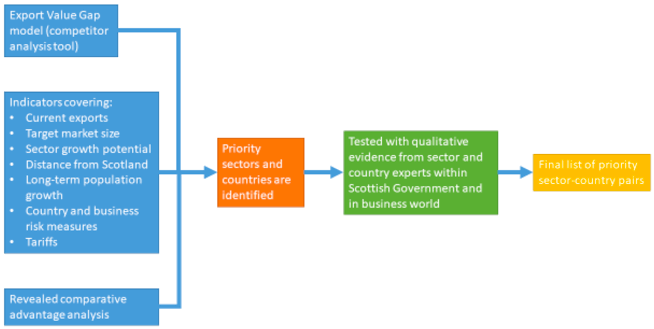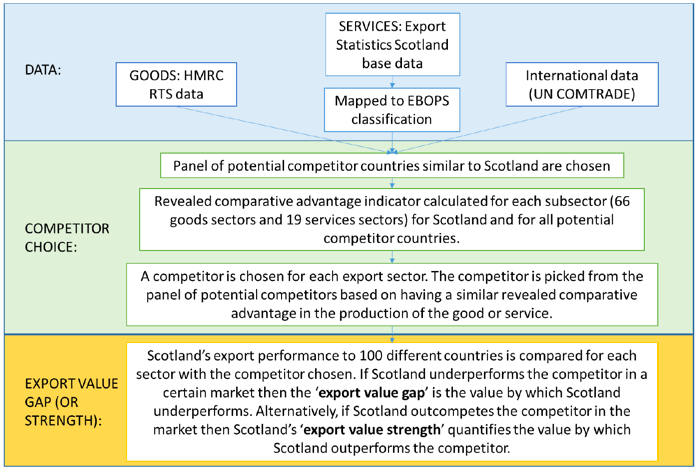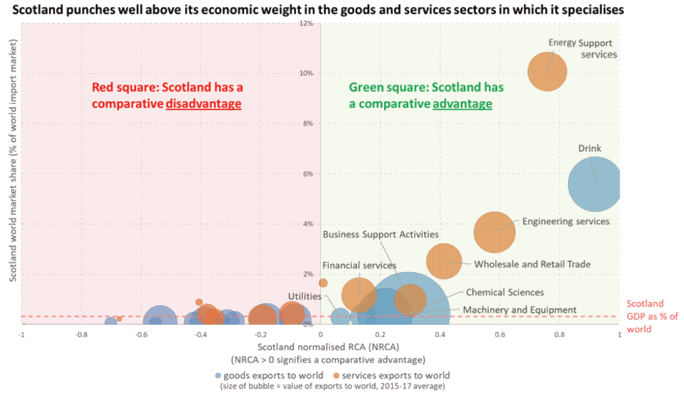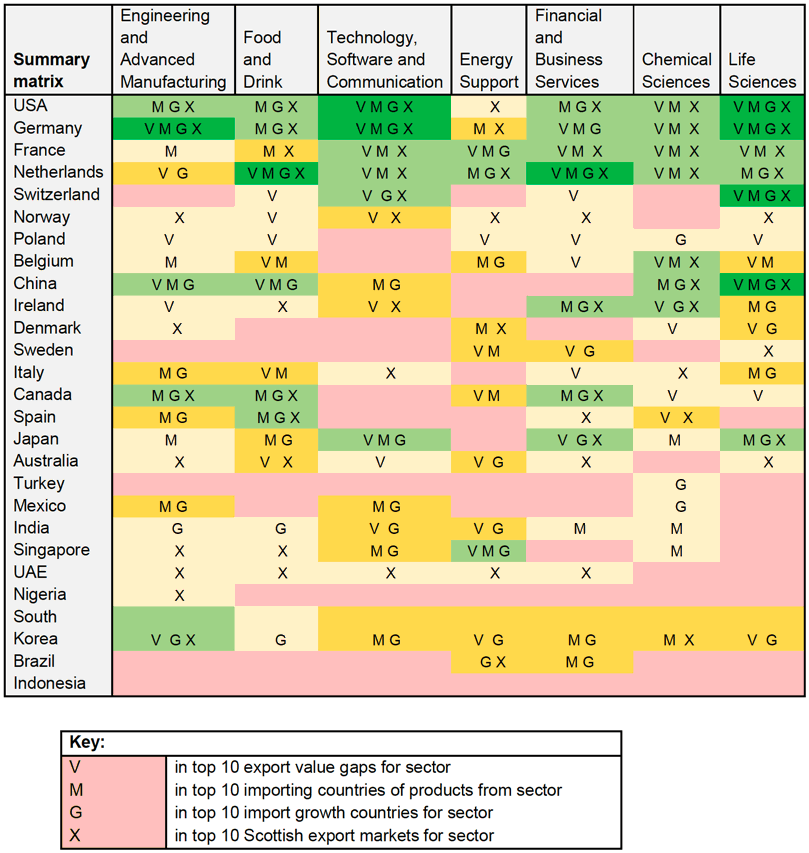A Trading Nation: analytical methodology note
An analytical methodology note produced to accompany the publication of A Trading Nation - a plan for growing Scotland's exports
4. Choosing priority sectors and countries
50. Figure 5 shows a simplified flow chart showing the main inputs into the analysis. The main analytical inputs can be broken down into three broad categories: the Export Value Gap tool, other calculated indicators and measures of revealed comparative advantage. These three analytical inputs are treated in turn in this section.
Figure 5: Flow chart; analytical process for country and sector prioritisation

4.1 Export Value Gap tool
51. To help understand Scotland’s export performance in different sectors and markets around the world and to identify opportunities to increase exports, economists in the Office of the Chief Economic Adviser have built a model that uses trade data to compare Scotland’s export performance to that of similar competitors in markets around the world.
52. The Export Value Gap model takes Scotland and UK level data and matches it to international trade data collected by UN COMTRADE. This matching makes it possible to compare Scotland’s exports to those of a competitor country across different sectors and countries. Where Scotland underperforms a similar competitor country, the model quantifies an ‘export value gap’ – i.e. the additional value that could be achieved if Scotland were to improve its export performance to that of the competitor.
53. The model is calculated across 66 goods sectors and 19 services sectors. 100 countries are included. ANNEX A sets out a list of the sectors and countries included in the model.
54. Figure 6 sets out the schema for the tool.
Figure 6: Export Value Gap - Model schema

55. Each step of the schema is now described in detail.
Data: mapping export data to EGP sector definitions
56. The goods data used in the model is based on HMRC RTS (described in more detail in Section 3). The model is calculated at the most disaggregated level for which this data is available (SITC2). The services data in the model comes from the Export Statistics Scotland base data. This base data is classified using the SIC classification. This is mapped to the Extended Balance of Payments Services (EBOPS) classification to make it comparable with international services data. The mapping used can be found in Table 7 in ANNEX A.
57. The need to map services data from one classification to another has some drawbacks. In particular, SIC and EBOPS classifications do not align perfectly, so there is inevitably a loss of accuracy through mapping sector data from one to the other.
Competitor Choice: revealed comparative advantage indicator
58. To better understand where Scotland’s export strengths lie, an indicator of ‘revealed comparative advantage’ is calculated.
59. 59. Absolute advantage is where a country can produce a good or service more efficiently than other countries. Countries benefit from trade where they specialise in producing goods/services in which they have an absolute advantage. Comparative advantage is where a countries specialises even if some of them do not have an absolute advantage, but where trade allows them to optimise their production to maximise the overall efficiency of production. Theory suggests therefore that a country should focus on producing goods and services in which it has a comparative advantage and then export these to the rest of the world. It should, in turn, import those goods and services which it has a comparative disadvantage in producing. This should, in theory, lead to increases in total trade and welfare gains, as production is located where it is most efficient.
60. The Revealed Comparative Advantage (RCA) indicator aims to provide a measure of comparative advantage by observing past and current trade flows. It is defined as follows (where i is a good or service sector and j is the country):

61. Intuitively, the RCA indicator calculates the degree to which countries are specialised in the export of a good or service, as compared to the world average degree of specialisation. If a country is more specialised than the world average, the country is said to have a ‘revealed comparative advantage’.
62. In practice it is easier to use a normalised version of the RCA, called the Normalised Revealed Comparative Advantage (NRCA) indicator. This indicator is more intuitive to use as it is bounded by -1 and 1, with a negative number meaning a comparative disadvantage and a positive number a comparative advantage. It is defined as follows:

63. Figure 7 shows the normalised revealed comparative advantage index for Scotland plotted against Scotland’s market share in world import markets for each sector. This shows that Scotland specialises in a handful of export sectors such as oil and gas related services (which make up ‘energy support services’ and some of ‘engineering services’), drink, wholesale and retail trade and business support activities. In these sectors Scotland punches well above its economic weight, in the sense that Scotland’s world market share is significantly higher than the Scottish economy’s total share of world output (as measured by GDP), represented by the red dashed line.
Figure 7: Scotland’s normalised revealed comparative advantage and world import market share

Source: OCEA calculations based on HMRC RTS, Export Statistics Scotland 2017 and UN COMTRADE data
Note: the international market share calculations should be treated with caution as results are likely to be affected by imperfect data mapping between different classifications
64. It should be noted that for the purposes of clarity the normalised revealed comparative advantage indicator in Figure 7 has been calculated at an aggregated sector level. When calculated at a more disaggregated level, other subsectors would appear in the comparative advantage box (e.g. fisheries).
Competitor Choice: Choosing competitor countries
65. For each export sector, the model picks a similar international competitor to compare Scotland’s exports to. The potential competitors have been chosen based on having a similar population, export mix and current trading arrangements with other countries. They are also chosen based on their geographical location – the economic literature strongly supports the notion that the geographical distance between two countries is a major determinant of the amount they trade, so the countries picked are all in Northern Europe.
66. The possible competitor countries differ for goods and services. For goods, the panel of possible competitor countries identified are Norway, Denmark, Finland and Ireland. For services, due to the lack of international data available a different selection of competitors must be made. The panel of possible competitors for services identified are Belgium, Denmark, Ireland, the Netherlands, Sweden, and Poland.
67. For each export sector, the most similar competitor country is chosen from the potential panel. Scotland’s performance in a given sector is compared to competitors based on the ‘Revealed Comparative Advantage Index’ (RCA) described above. The RCA index is calculated across 66 goods sectors and 19 services sectors for Scotland and for all the competitors outlined above. The competitor who is most similarly competitive globally (i.e. has as similar a RCA index as Scotland) is chosen.
68. Intuitively, for each export sector the model finds a comparator country that exports about as much of the good globally as a proportion of its total global exports as Scotland does. It then compares Scotland’s exports to 100 countries in this sector to this chosen competitor to assess whether Scotland is underperforming or outperforming, and to what extent.
69. One other modification is made. A wealth of qualitative evidence shows that countries tend to trade most with other countries with which they share a land border. For example, 60% of Scotland’s exports go to the rest of the UK[17]. To make sure that the comparison with each chosen competitor is fair, the choice of competitor is screened to remove contiguous pairs (e.g. it would be an unfair comparison to compare Scotland’s exports to Germany to those of Denmark, as Denmark shares a land border with Germany). In the case that the chosen competitor and target market are contiguous, the second-best choice competitor is chosen instead.
70. Table 9 and Table 10 in ANNEX A show the chosen competitor countries for each goods and services sector.
Export value gap: calculation of ‘export value gap’
71. Once the competitor is chosen then the ‘export value gap’ can be calculated.
72. The ‘export value gap’ is defined as the difference in value between Scotland’s exports to a certain market and the exports of the chosen competitor to that same market. For example, Scotland exported £174m worth of professional and scientific instruments to the USA annually on average over the period 2015-17. Finland, which is identified as a similar competitor to Scotland in this sector, exported £521m annually on average over the same period. The difference, £347m, is defined as the ‘export value gap’.
73. ‘Export value gaps’ are calculated for each sector-country pair. These can then be aggregated as desired by summing over countries or sectors. The sum of all the ‘export value gaps’ across all export sectors and target markets gives the total world ‘export gap’ – at more than £14bn, this represents the value that Scotland could gain if exports were increased in each sector and market to that of the chosen competitors.
74. It is very important to note that the tool has some limitations that mean its outputs must be treated carefully. In particular, the model is defined at the SITC2 classification level for goods and the EBOPS level for services.[18] This is the most detailed level of available data for Scottish exports. While this does provide a reasonable level of disaggregation, the categories still contain a range of sometimes quite different products and services. This implies that it would be possible for the tool to select a competitor that is somewhat similar to Scotland at the broader sector level, but that actually produces goods within that sector code that are quite different to those that Scottish businesses produce.
75. Because of this crucial limitation the model is intended to point out potential opportunities that should then be cross-checked with country and sector experts. This cross-checking and testing has been carried out by the project team, and is described in more detail in the main report accompanying the release of the Export Growth Plan.
4.2 Other indicators used in the analysis
76. In addition to the Export Value Gap tool and revealed comparative advantage index, a range of other indicators are calculated to assist in the selection of priority countries and sectors. There are many factors that need to be assessed to identify the existence of an export opportunity. The size, scope and precise nature of each opportunity is likely to be different and the barriers to Scottish businesses ability to exploit it will vary.
77. For each country and each sector, the other indicators that have been considered fall in to five broad categories: current exports and market size; sector and market growth potential; competitor analysis; and country risk and trade barriers.
78. These additional indicators allow for a wider consideration of market and sector opportunities by considering other factors such as distance to market, size of the import market for a particular sector, historic import market growth over time, future projected import market growth, Scotland’s export growth over time, country risk indicators and population change.
79. Table 11 in ANNEX A sets out the indicators used for sector prioritisation. Table 12 sets out those used for country prioritisation.
Weighting indicators
80. In order to combine the indicators and calculate an aggregated score for each country and sector a weighting is applied to each indicator. An initial weighting is applied based on judgement over the perceived relative importance of different indicators in the prioritisation decision.
81. The weighting process is applied as follows. For each indicator, countries are given a score equal to their ranking relative to other countries. For example, since the United States is Scotland’s largest single-country export market, the United States gets the score ‘1’ under the indicator ‘Scottish exports to market’. Note that lower numbers indicate a higher rank.
82. Once every country has received a score for all indicators the weighting scheme is applied. This is done by multiplying the initial score by the indicator weight. An average ranking score is then calculated for each country by averaging the weighted scores for that country and dividing through by the sum of the weights in the weighting scheme.
83. By this process a ranked list of countries is generated for each weighting scheme. The same process is followed to generate a ranked list of sectors based on the sector indicators.
84. While all care is taken to ensure that the initial weighting is reasonable, extensive sensitivity testing is carried out to verify that the country and sector choices are robust to individual judgement. This sensitivity testing is carried out by varying both the scale of the weighting and the relative weighting of different indicators. Full details of the weightings used can be found in Table 13 and Table 14 in ANNEX A.
85. Table 2 shows that the results of this process are robust to the choice of both the scale and the relative importance of different weightings, with most countries in the top 10 appearing across all rankings.
Table 2: Country ranking – sensitivity testing
| Rank | Final Weighting | Testing Sensitivity of Scale of Weighting | Testing Sensitivity of Weighting Decisions | ||||||
|---|---|---|---|---|---|---|---|---|---|
| Weighting 1.1 | Weighting 1.2 | Weighting 1.3 | Weighting 1.4 | Weighting 2.1 | Weighting 2.2 | Weighting 2.3 | Weighting 2.4 | ||
| 1 | United States | United States | Germany | Germany | United States | United States | United States | Irish Republic | United States |
| 2 | Germany | France | United States | United States | Germany | France | France | United States | Irish Republic |
| 3 | France | Germany | Netherlands | Netherlands | France | Germany | Irish Republic | France | Norway |
| 4 | Netherlands | Netherlands | France | France | Netherlands | Denmark | Germany | Turkey | France |
| 5 | Switzerland | Irish Republic | Poland | Poland | Irish Republic | Norway | Switzerland | Germany | Denmark |
| 6 | Norway | Switzerland | Italy | Italy | Switzerland | Irish Republic | Norway | Netherlands | Germany |
| 7 | Poland | Denmark | Norway | Norway | Denmark | Netherlands | Denmark | Norway | Turkey |
| 8 | Belgium | Canada | Belgium | Belgium | Norway | Switzerland | Netherlands | Denmark | Switzerland |
| 9 | China | Norway | Switzerland | Switzerland | Canada | China | China | Canada | Netherlands |
| 10 | Irish Republic | Belgium | Sweden | Sweden | China | Turkey | Turkey | Switzerland | Nigera |
86. Finally, an additional exercise is conducted to identify those markets that may not come top when compared against the broad indicators across all sectors, but that may have particular importance for certain export sectors. These countries are identified through current export flows and sector/country knowledge.
87. Table 3 shows the countries identified as priorities.
Table 3: Priority countries identified
| Immediate opportunities in multiple sectors |
Specific sectoral opportunities in the mid to long term |
|---|---|
| 1) USA |
16) Japan |
| 2) Germany |
17) Australia |
| 3) France |
18) Turkey |
| 4) Netherlands |
19) Mexico |
| 5) Switzerland |
20) India |
| 6) Norway |
21) Singapore |
| 7) Poland |
22) UAE |
| 8) Belgium |
23) Nigeria |
| 9) China |
24) South Korea |
| 10) Irish Republic |
25) Brazil |
| 11) Denmark |
26) Indonesia |
| 12) Sweden |
|
| 13) Italy |
|
| 14) Canada |
|
| 15) Spain |
|
88. Table 4 shows these priority countries plotted in a matrix against the priority sectors identified. The cells in the matrix provide some further information that helps to illuminate the reason for the prioritisation, and the sectoral pattern of opportunities in the countries. The matrix is colour coded from bright green indicating a high potential opportunity through to red which suggests no particular opportunity identified in that sector and country.
Table 4: Priority countries and sectors - matrix

Source: OCEA calculations based on Export Statistics Scotland and UN COMTRADE data
Contact
Email: stefan.hoyte@gov.scot
There is a problem
Thanks for your feedback